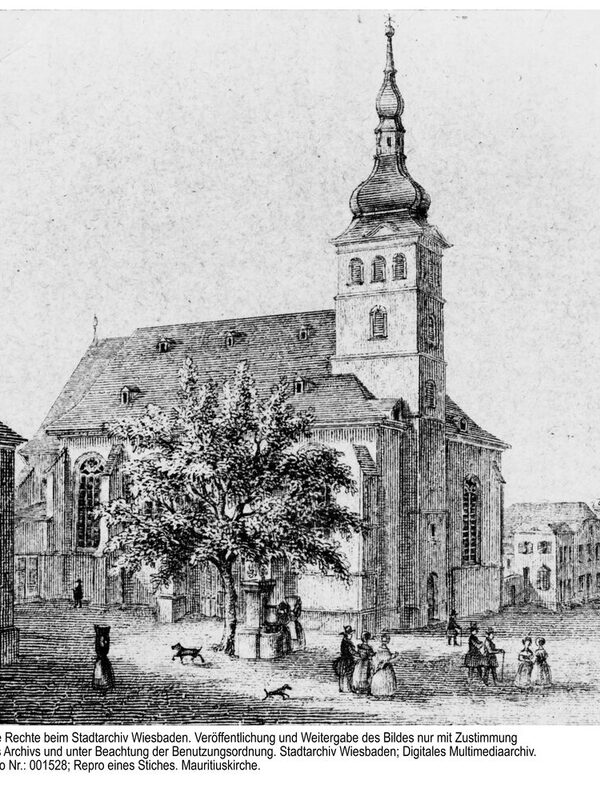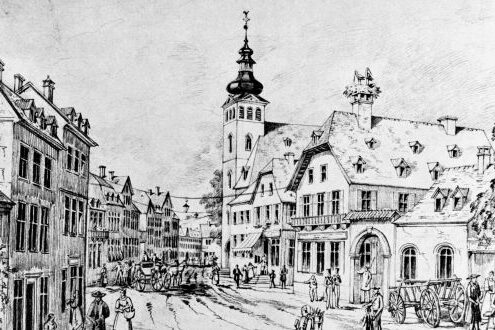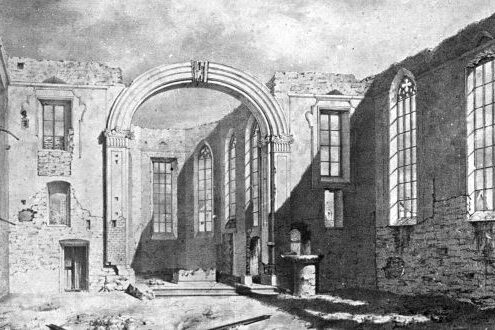Mauritius Church
Until its destruction in 1850, the Mauritius Church was the ecclesiastical center of the town. The first stone church building on this site was erected at the end of the 8th century. The foundation stone for the fourth Mauritius Church was finally laid on February 14, 1488.
The historic Mauritius Church was the ecclesiastical center of Wiesbaden until its destruction by fire on July 27, 1850. Excavations between 1850 and 1853 revealed that it had three predecessor buildings. Probably around 780/90, a first stone church was built on today's Mauritiusplatz on an elongated, rectangular ground plan, a Carolingian hall building. This was replaced before the turn of the millennium by an early Romanesque basilica, probably with three naves and a choir apse, which was possibly consecrated in April 965 in the presence of Emperor Otto I (912 - 973). Otto I had chosen St. Mauritius, who according to legend was the leader of the Thebaic Legion and died a martyr's death, as the patron saint of his undertakings. It is conceivable that the new church was given the patronage of St. Maurice on the occasion of the emperor's visit.
After repeated destruction in 1242 and 1318, it was decided to rebuild the church. The builder of the third Mauritius church was probably Count Gerlach (approx. 1283 - 1361), son of the German King Adolf Count of Nassau. This building was constructed after 1320 with a single nave in Gothic style, a polygonal choir end and a tower in the west, facing Kirchgasse. In the 15th century, structural damage became increasingly noticeable. The church had also become too small for the congregation and so a new building was discussed again from 1465.
The foundation stone for the fourth Mauritius Church was finally laid on February 14, 1488 under Count Adolf III of Nassau (1443 - 1511). Compared to the previous building, the plan was for a much larger three-aisled late Gothic hall church. However, only a new choir with a polygonal end and two rooms adjoining the western bay of the choir to the north and south were built. The tower was also rebuilt. The construction then came to a standstill due to a lack of funds and the newly built eastern section was unceremoniously connected to the preserved nave of the previous building. However, its central axis no longer coincided with that of the new choir, as the latter had been moved further south. This church was consecrated in 1521.
After Count Philip II the Elder (1492 - 1558) introduced the Lutheran confession in 1540, the Mauritius Church became Lutheran and the first Protestant pastor was appointed on January 1, 1543. During the great town fire of 1547, the church was also badly damaged. The roof truss and tower were burnt out, but both were quickly rebuilt. In 1592, when the Catholic furnishings had largely disappeared, the church was given a magnificent stone pulpit.
After the Thirty Years' War and the accession to power of Georg August Samuel Prince of Nassau-Idstein in 1688, efforts were once again made to build a new church that would provide sufficient space for the growing town population to worship. In 1717, the reconstruction and extension of the existing Mauritius Church began according to plans by the court architect and master builder Johann Jakob Bager the Elder (~1670 - 1739). The urban planning situation was problematic, as it made it impossible to extend the nave. While the choir section minus its western bay and the tower were retained, the older nave was demolished and the new nave was extended to the width of the east section from 1488 and extended to Kirchgasse so that it surrounded the tower on three sides. The sacristy was built in the south-east corner, between the choir and the new nave.
The Wiesbaden painter Philipp Daniel Bager (around 1700 - after 1755), son of Johann Jakob Bager the Elder, painted the walls, galleries and parts of the ceiling inside the church around 1750. In 1768, the tower was finally renovated and heightened and fitted with a baroque onion dome with lantern, a weathercock and new bells. In 1804, the organ was moved from Eberbach Abbey in the Rheingau to the Mauritiuskirche and, after extensive renovation work, installed in the choir. In 1818, the church finally received a new altar made of black Nassau marble.
In July 1850, the church burned to the ground. The beams had caught fire during tinsmith work on the tower lantern. Courageous citizens rescued the coffin of the first wife of Duke Adolf of Nassau, Duchess Elisabeth Mikhailovna Romanova, and that of her child from the burning church. However, the tomb monuments of the Nassau count's family in the church fell victim to the flames. The Mauritius Church was not rebuilt, as the remaining outer walls were no longer strong enough for an interior extension, according to an expert opinion by building consultant Richard Goerz.
An expiatory cross and the foundation stone from 1488 survived the fire and are now in the church of St. Mauritius in Abeggstraße. The names of Kirchgasse, Kleine Kirchgasse, Mauritiusstrasse and Mauritiusplatz are reminders of the church to this day.
Literature
- Wolf, Stefan G.
Churches in Wiesbaden. Places of worship and religious life in the past and present, Wiesbaden 1997 (p. 28 f.).
- Czysz, Walter
Ten-part series of articles on the Mauritiuskirche. In: Wiesbadener Tagblatt. (4.6.-8.6. and 11.6.-15.6.2002)
- Gerber, Manfred; Sawert, Axel (Fotos)
Heavenly towers. The Market Church in Wiesbaden, Bonn 2012 (pp. 46-53).


